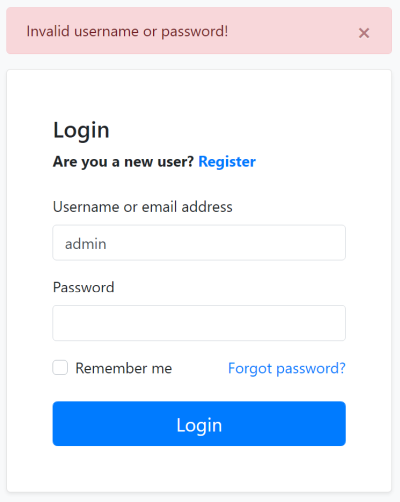3.0 KiB
ASP.NET Core MVC / Razor Pages: Page Alerts
It is common to show error, warning or information alerts to inform the user. An example Service Interruption alert is shown below:
Basic Usage
If you directly or indirectly inherit from AbpPageModel, you can use the Alerts property to add alerts to be rendered after the request completes.
Example: Show a Warning alert
namespace MyProject.Web.Pages
{
public class IndexModel : MyProjectPageModel //or inherit from AbpPageModel
{
public void OnGet()
{
Alerts.Warning(
text: "We will have a service interruption between 02:00 AM and 04:00 AM at October 23, 2023!",
title: "Service Interruption"
);
}
}
}
This usage renders an alert that was shown above. If you need to localize the messages, you can always use the standard localization system.
Exceptions / Invalid Model States
It is typical to show alerts when you manually handle exceptions (with try/catch statements) or want to handle !ModelState.IsValid case and warn the user. For example, the Account Module shows a warning if user enters an incorrect username or password:
Note that you generally don't need to manually handle exceptions since ABP Framework provides an automatic exception handling system.
Alert Types
Warning is used to show a warning alert. Other common methods are Info, Danger and Success.
Beside the standard methods, you can use the Alerts.Add method by passing an AlertType enum with one of these values: Default, Primary, Secondary, Success, Danger, Warning, Info, Light, Dark.
Dismissible
All alert methods gets an optional dismissible parameter. Default value is true which makes the alert box dismissible. Set it to false to create a sticky alert box.
IAlertManager
If you need to add alert messages from another part of your code, you can inject the IAlertManager service and use its Alerts list.
Example: Inject the IAlertManager
using Volo.Abp.AspNetCore.Mvc.UI.Alerts;
using Volo.Abp.DependencyInjection;
namespace MyProject.Web.Pages
{
public class MyService : ITransientDependency
{
private readonly IAlertManager _alertManager;
public MyService(IAlertManager alertManager)
{
_alertManager = alertManager;
}
public void Test()
{
_alertManager.Alerts.Add(AlertType.Danger, "Test message!");
}
}
}
Notes
AJAX Requests
Page Alert system was designed to be used in a regular full page request. It is not for AJAX/partial requests. The alerts are rendered in the page layout, so a full page refresh is needed.
For AJAX requests, it is more proper to throw exceptions (e.g. UserFriendlyException). See the exception handling document.

